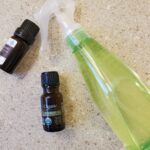Do you know what a dust mite even is?
We might all use the term. But until we understand what it actually means… Well, it’s pretty gross.
According to a research team at the National Institute of Environmental Health Sciences, the following is the precise definition:
“Dust mite allergens come from dust mites – microscopic spider-like animals that feed on house dust. Dust mites are common anywhere there is dust, such as in carpeting and beds. Some people are allergic to dust mite allergens and may develop asthma from living near them.”
So, dust mites are teeny bugs that feast on dust. They don’t bite humans, but they can cause a rash or skin redness in an allergic reaction. But that fact just begets a new question.
Where Does Dust Come From?
Dust comes the breakdown of physical matter breaking down. Much of the dust you find in your home comes in from the outdoors. But some of it also comes from you, your family, and your pets.
Here is some gross information. Brace yourself. Some things scientists find present when examining dust particles under a microscope include the following:
- Decayed cockroaches
- Legs and parts of other bugs
- Human skin cells shed by you and other people in your home.
- Hair follicles
- Plant pollen
- The dirt you track in from outside.
- Carpet fibers
- Pet hair
- Dandruff from human scalps
- Pet dander
In short, dust forms primarily from decaying organic compounds, with some synthetic fibers (like from your clothing or rugs) added to the mix.
When you think about it, it’s rather disgusting.
 Symptoms of Dust Mite Allergies or Asthma
Symptoms of Dust Mite Allergies or Asthma
As the NIH study mentioned, people may suffer from asthma and allergies because of dust mites in the environment.
But you can mistakenly overlook this diagnosis if you don’t know all the symptoms.
We turned to Healthline to put together this list of symptoms to help make you aware of the signs of a dust allergy:
- A runny or drippy nose
- An itchy nose
- Post-nasal drip
- Nasal congestion
- Your skin itches
- Facial pain due to sinus pressure
- Dry, itchy eyes
- Red or bloodshot eyes
- Watering eyes
- Dry or scratchy-feeling throat
- Dark circles around the eyes
- Difficulty in sleeping
- Difficulty in breathing
- Wheezing or feeling short of breath
- Insect feces
- Tightening of the chest (like you feel with bronchitis)
If you have these symptoms, it’s worth a call to your doctor to discuss whether you have a cold or virus…or if you have a dust mite allergy. Your family physician can perform a skin-prick or blood test to isolate allergies and get you fast relief from your symptoms.
Of course, if you feel tightening of the chest and suspect you might be having a heart attack, please call 911 immediately.

How to Make DIY Wood Cleaner Spray to Kill Dust Mites
Here’s a piece of excellent news–when you remove the dust, the dust mites don’t have anything to eat.
To break this infestation, kill the dust mites and remove the dust that serves as their nutrition.
There are many commercial dusting sprays on the market. However, a quick read of the label shows that they are full of chemicals, preservatives, and unpronounceable ingredients. Furthermore, they come in an aerosol can, which can further irritate your allergies or even cause an asthma attack.
Enter our old friend, Mother Nature.
She provides all that we need to vanquish dust mites and get back to enjoying better health.
Dust Mite Killing Wood Spray Supply List
Here are the few supplies you need to make your natural, calming dusting spray. Personally, I have battled asthma almost since birth. This formula is exactly how I make my wood cleaning spray, and I thought it was worth sharing in case it can help anyone else find some relief.
8 oz spray bottle:
You can use a larger spray bottle if you wish. However, the oils break down relatively quickly. It makes sense to mix smaller batches that you’ll use faster than to whip up a giant batch that turns stale.
Sunflower oil or fractionated coconut oil:
Adding these natural oils imparts moisture to the wood, leaving a beautiful sheen. Also, it helps by trapping the dust and mites in your cleaning cloth as you work.
Rosemary essential oil:
A university study in Egypt proved that the camphor present in rosemary essential oil helps eliminate these microscopic pests. My preferred product is Clinganic Rosemary Essential Oil. an organic brand.
Lavender essential oil:
Studies published over and over again conclude that lavender contains natural anti-inflammatory impacts. This herb helps to decrease inflammation in the airways., Natural healers relied on this ingredient to treat breathing-related diseases for many centuries, and now modern researchers agree.
The fragrance combination of rosemary and lavender essential oil is fresh and pleasant but not overbearing.
Distilled Water:
Tap water contains minerals that might leave a haze. Think of the limescale build-up on your coffeemaker as a case in point.
White Vinegar:
Vinegar is a natural disinfectant that will help neutralize any fecal matter the little buggers leave behind. While you would never want to use straight-up white vinegar on wood furniture, you will dilute it in this mixture.
Permanent marker:
You should label your bottle with an indelible marker. If anyone else in your family decides to clean (ha ha ha), they will know what to use. You can also make a cute label. To be perfectly honest, I always say I’ll make a label but never do. Heck, some days are so busy I can barely find time to take a shower, let alone make labels for my homemade cleaning supplies.
Dust Mite Killing Wood Cleaning Spray (DIY)
Equipment
- No tools necessary!
Materials
- 6 ounces of distilled water
- 2 tablespoons of white vinegar
- 2 teaspoons of sunflower oil
- 25 drops of lavender essential oil
- 20 drops of rosemary essential oil
- permanent marker
- 8 ounce spray bottle
Instructions
- Add all the ingredients to the 8-ounce spray bottle.
- Cap tightly, give it a nice shake.
- Use the marker to note the contents on the outside of the bottle
Notes
Do note that you’ll need to shake the bottle before and during use while you are cleaning. Remember that oils and water do not mix!
Also, know that you can play with the strength of the scent by adding more–or fewer–essential oils. I personally find this to be a pleasing fragrance, but aroma preferences are very subjective. Feel free to experiment. You might even want to brighten the fragrance with a few drops of orange, lime, or lemon essential oils. How fun would that be?
The Bottom Line: Mother Nature Helps You Kill Dust Mites Without Harsh Chemicals
This wood cleaning spray works exceptionally well to remove that build-up if you use it a couple times a week. You will still need to perform seasonal deep cleanings to keep your home sanitary. But overall, controlling the dust mite population is a great way to improve your breathing while helping to be more eco-friendly.



